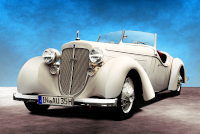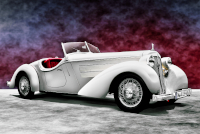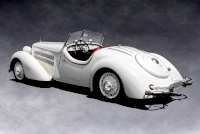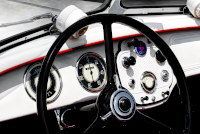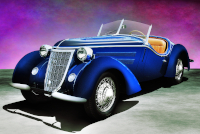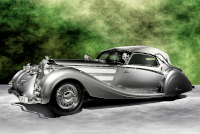Location:
Pebble Beach Concours d'Elegance, 2009
Owner: Audi AG | Ingolstadt, Germany
Prologue:
Reclaiming an old profile, I don't harbor any particular fondness for Auto Union history apart from its rather significant influence on soft power in the years leading up to World War II. But the opportunity to see and photograph a few rare examples arrived in 2009 at Pebble Beach. And so this and a couple other profiles became part of the original catalogue many years ago. A mere 15 years later, I've recovered the material and updated the images.
These images, though thoroughly reworked, still seem weak to me, even if I do like the tail perspective. An unfortunate spell of sunshine that Monterey afternoon hit the white paint a bit hard, and there simply isn't enough digital information in the original images to blend fiction with visual fact.
I try not to apologize for my work, but I will make concessions for an entry that warrants attention. The Front 225 is special in this respect, even if only for the chance to translate, 'Umgekehrter.' That is the crux, anyway, a roadster powered by a turned-around motor. And the car represents a heritage project from an automaker not known for its heritage.
Audi are more or less the iPhone of luxury automobiles, endlessly replaceable with the next model. Few recall anything of the marque prior to Quatro rally fame. But with this recreation the automaker wished to revise that impression. Like most Auto Union achievements, I can only feel conflicted about the car's apparent grace. But the historical context makes the exercise worthwhile.
- - - - - - - - - -
► Image Source: Nikon D200 (10.2 MP)
References:
- Autoblog: A full transcript of the 2009 Audi Heritage press release, context for the Special Roadster recreation.
- Wikipedia: General information on the Audi Front UW 220 and 225.
Back in 2009, already a bygone era, Audi reached its centennial. To celebrate, Audi Tradition, the marque's heritage division, put together a special exhibition for its museum in Ingolstadt. Among those selected pieces, they commissioned a recreation of the Front UW 225 Special Roadster. Audi supplied an original chassis to Technische Restaurationen Werner Zinke of Zwönitz, Sachsen, who used archive photographs to reconstruct the car.
Audi originally built just two of the Special Roadster, and neither survive. But the low production figures seem less a measure of exclusivity than practicality.
The Front UW 220 evolved from the mass-market DKW, a concept to capitalize on the emerging popularity of front-wheel drive by moving the platform up-market. Jørgen Skafte Rasmussen, the Danish industrialist who organized Auto Union, had at his disposal the means to pull together a complete car using an Audi platform, Wanderer mechanicals, and DKW configuration.
Such was the synthesis of Auto Union companies that, at the inception of the UW 220, the Audi plant was fully occupied producing DKW cars, and so production began at the Horch factory in Zwickau. Unsurprisingly, these front-drive Audi cars resemble the Horch 853, particularly those that share Gläser coachwork.
The Special Roadster carries over similar Horch design cues, notably the grille and wrap-around brightwork. But the roadster concept is not particularly fitting for the platform, which perhaps explains why only two were made.
The Front UW 220 and 225 are not particularly powerful, and the reversed motor with gearbox mounted in front requires long, ungainly shift linkage. The drive quality is therefore subordinate to the novelty of the concept, a docile pleasure-cruiser that would not have bothered Mercedes-Benz, apart from Audi's ability to claim a market niche as its own.
In this respect, Audi did not need a front-drive roadster, and the car's handling and performance characteristics would have probably precluded any suggestion of creating one on its own merit. I'm speculating, but then in the Auto Union catalogue, that role would be filled by the Wanderer W25K.
So it feels as if the Front UW 225 Special Roadster project is perhaps unnecessary, if the two originals weren't commercially viable to start with. Certainly the car is interesting, particularly for an American audience, but in that way of recognizing something that we weren't ever aware of. It is a piece of automotive essoterica.
And yet petrolheads will remember some fuss at the time. Of course Audi shipped the car to Pebble Beach, and CMC produced a high-end 1:18 model of the car in various liveries. So the recreation is a heritage project, but one that represents a technical platform that was better known as a Horch stablemate, the best of which are of the cabriolet variety.
Motor: 2,257 cc straight 6-cylinder | 71 mm x 95 mm
The Front UW inherited the Wanderer 6-cylinder plant, but turned the block around to create a grown-up version of the front-drive DKW.
Valvetrain: OHV, 2 valves per cylinder
Power: 54 bhp @ 3,800 rpm
Drivetrain: 4-speed gearbox, rear-wheel drive
The box uses synchromesh on the third and fourth gears. While applauded in its day, the long action of the gear lever creates a disjointed feel when shifting. The lever extends out from under the dashboard and connects over one meter ahead to the gearbox in front of the motor, and there is no reverse lockout, so navigating the lever into each gear requires a deft touch and patience to withstand rough changes early in the gates.
Rear Suspension: swing axle, lateral leaf springs
Architecture: steel box-section frame
Wheelbase: 3,050 mm (120.07 inches)
Top Speed: 100 km/h (about 62 mph)
Auto Union claimed a 100 km/h top speed but did not differentiate that figure among variants. If any version of the Front UW could reach 100 km/h, the roadster should. But, contrary to Auto Union's extraordinary Grand Prix program, these road cars a low-powered cruisers, and somewhat ungainly for their front-drive layout.
Etymology:
Straight up, the 'Front' designation identifies the front-drive layout, whereas 'UW' means 'umgekehrter Wanderer.' The car is essentially an up-rated Wanderer W22 with its motor reversed to drive the front wheels.
Because of this front-drive platform change, the Audi does without the typical German 'W' nomenclature, where 'W' refers to 'wagen' (or 'car' in German) and the number refers the serial project number. So the Wanderer W22 gives birth to the up-market UW 220 in 1933. And when the motor capacity increases in 1935, the model becomes the UW 225.
The coincidence of 'UW225' pairing the 2,257 cc motor is happenstance, as Auto Union numbers do not follow motor capacity. For instance, the Wanderer W22 and Audi Front UW 220 use a 1,950 cc motor.
The UW 225 version depicted here is the Special Roadster, which would have been, 'Spezial' in German.
Figures:
Audi produced more than 4,400 Front UW vehicles, with 1,817 UW 220 cars built through 1934 and 2,591 UW 225 cars built through 1938. Of all versions, Audi produced only two Special Roadsters in 1935; neither survived. This vehicle is the result of an Audi commission to prepare a recreation on an original chassis for a 2009 celebration of marque heritage.
Bonnet Length: Louvres and Layout around the Front-Drive Platform
The Front UW 225 uses the extra length of the in-line gearbox and reverse-motor configuration to gain stature, but otherwise conceals its front-drive platform. The long bonnet looks as though it may contain a straight-8, and nothing in the fascia indicates the mechanical configuration between the front wheels. Demonstrated in this roadster as well as in the lovely Front UW cabriolet, the stature keeps very much upright, portraying a silhouette similar to the conventional rear-drive Horch 853. In this sense, Audi strives to maintain common Auto Union themes by keeping the proportions of the body roughly equal to those of its stablemates.
In turn, the coachwork operates in roughly the same manner, with tall bonnet lines, two long rows of louvres, and a single chrome belt that wraps around the cockpit in the style of Erdmann & Rossi. The treatment also pairs that of the Wanderer W25K by Wendler, but the Audi does not share the Wanderer's sporting character, even if it looks like it should.
Unattributed Style: Auto Union Cues in the Front UW 225 Design
Audi's classic era grille follows the form of heraldic shields common to the broader Front UW 220 and 225 cars, similar to that of the Horch 853. Less obvious but absolutely integral to the Auto Union theme, the front valance is altogether smooth with only just enough lip along the leading edge to hold the chin of the grille in place. This smooth, faired-in attribute originated as early as 1932 with the Maybach DS8 Typ Zeppelin Stromlinien, though Auto Union may have borrowed more American influence.
Auto Union uses this flowing, grille-forward fascia across marques on its best automobiles, with custom coachbuilders holding to the theme. In contrast, contemporary Mercedes-Benz grilles are deep-set between the skirts, with traditional dumb irons and shrouds that sit well ahead of the front wheels.
Last Updated: Apr 10, 2025

